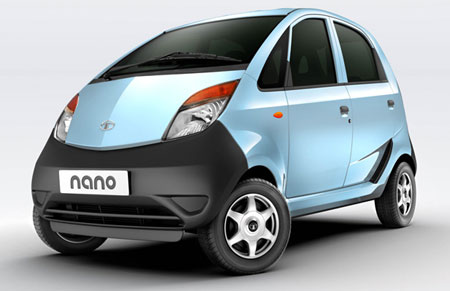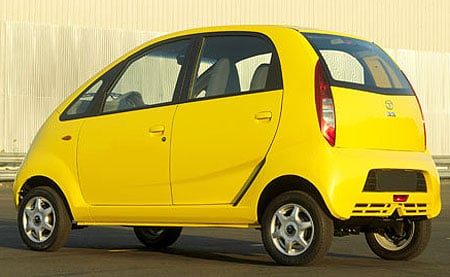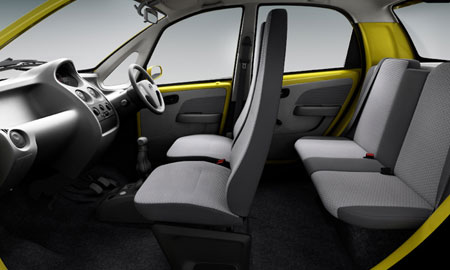
The Tata Nano is officially here and on sale! Bear in mind this is the Indian domestic market version and not the larger, more well-equipped version that was showcased as the Tata Nano Europa recently.
The Indian version of the Nano will go on sale from the 1st of April onwards at Tata Motors Passenger Car dealerships and other select authorised outlets, available in 3 variants – Standard, CX and LX, with a 24,000km or 18 month warranty. The cheapest one is priced at 1 lakh as promised, but only when it leaves the factory, after that it gets some other costs tagged on including shipping, taxes and registration.
The Tata Nano has its engine mounted at the back, a 624cc 2-cylinder aluminium multi-port fuel injection engine mated to a 4-speed transmission. The engine produces 35 PS at 5,250rpm and 48Nm of torque at 3,000rpm, with a top speed of 105km/h.
Not much power, but the car weighs only 600kg. It can negotiate a maximum of a 30% grade incline. Fuel efficiency is rated at 23.6 km/litre, certified by the Automotive Research Association of India (ARAI) under mandated test conditions – this is said to be the most fuel efficient petrol car in India.

The Nano measures just 3,100mm long, with a width of 1,500mm and a height of 1,600mm. Tata claims despite it having the smallest exterior footprint of any car in India, it is 21% more spacious than the smallest car available today.
The Standard is very bare, with 3 colour options, single-tone seats and a fold-down rear bench. If you notice, it doesn’t even have side view mirrors. The CX adds 2 more colours, climate control, two-tone seats, a parcel shelf, boost-assisted brakes, and a fold-down rear seat with a nap rest.
The highest grade LX model adds complete fabric seats, central locking, front power windows, body-coloured bumpers and etc, fog lamps, an electronic trip meter, a front console cup holder, a mobile charger point, and a rear spoiler.
There is limited capacity at the moment, as Tata’s Sanand plant is not ready yet in terms of capacity. The State Bank of India will be managing the Nano’s bookings. Application forms will be sold at Rs. 300 from 30,000 locations in 10,000 cities – Tata Motors Passenger Car dealerships, State Bank of India and its branches, its subsidiaries and associates, other preferred financiers, and outlets of Westside, Croma, ‘World of Titan’ and Tata Indicom exclusive stores.

After one obtains the form, he can either pay the entire booking amount themselves or seek financing of the booking amount. Financing is available from 15 financial institutions, where a Nano can be booked for Rs. 2999.
After 60 days of the closure of bookings, Tata will use a lottery system to allocate the first 100,000 cars to be delivered in phase 1 of the delivery process. Deliveries will start in July 2009.
If you do not get selected for the first phase of delivery, unlike here where your booking fee gets stuck for ages if your car takes a long time to get delivered, customers will be eligible to interest on their booking fees – 8.5% for retention period between one year to two year and 8.75% for a retention period of more than 2 years.
Look after the jump for a full gallery of the Nano.
Related Posts:
The Tata Nano: how did they manage to make it so cheap?
[zenphotopress number=99 album=198]
Looking to sell your car? Sell it with Carro.


AI-generated Summary ✨
Comments generally express excitement and optimism about the Tata Nano's affordability and potential to improve safety for families, especially in India where many travel on bikes with children. Some appreciate its simplicity, fuel efficiency, and environmental friendliness, seeing it as a solution for low-income families and to reduce motorcycle accidents. There are concerns about safety features, crash tests, and build quality compared to established cars like Proton or Toyota. A few skeptics worry about the car's safety, comfort, and suitability in local markets or heavy traffic conditions, while some off-topic discussions highlight environmental campaigns and vehicle modifications. Overall, the sentiment is positive towards Nano's social benefits, but there is cautious skepticism about quality, safety, and market readiness in Malaysia.